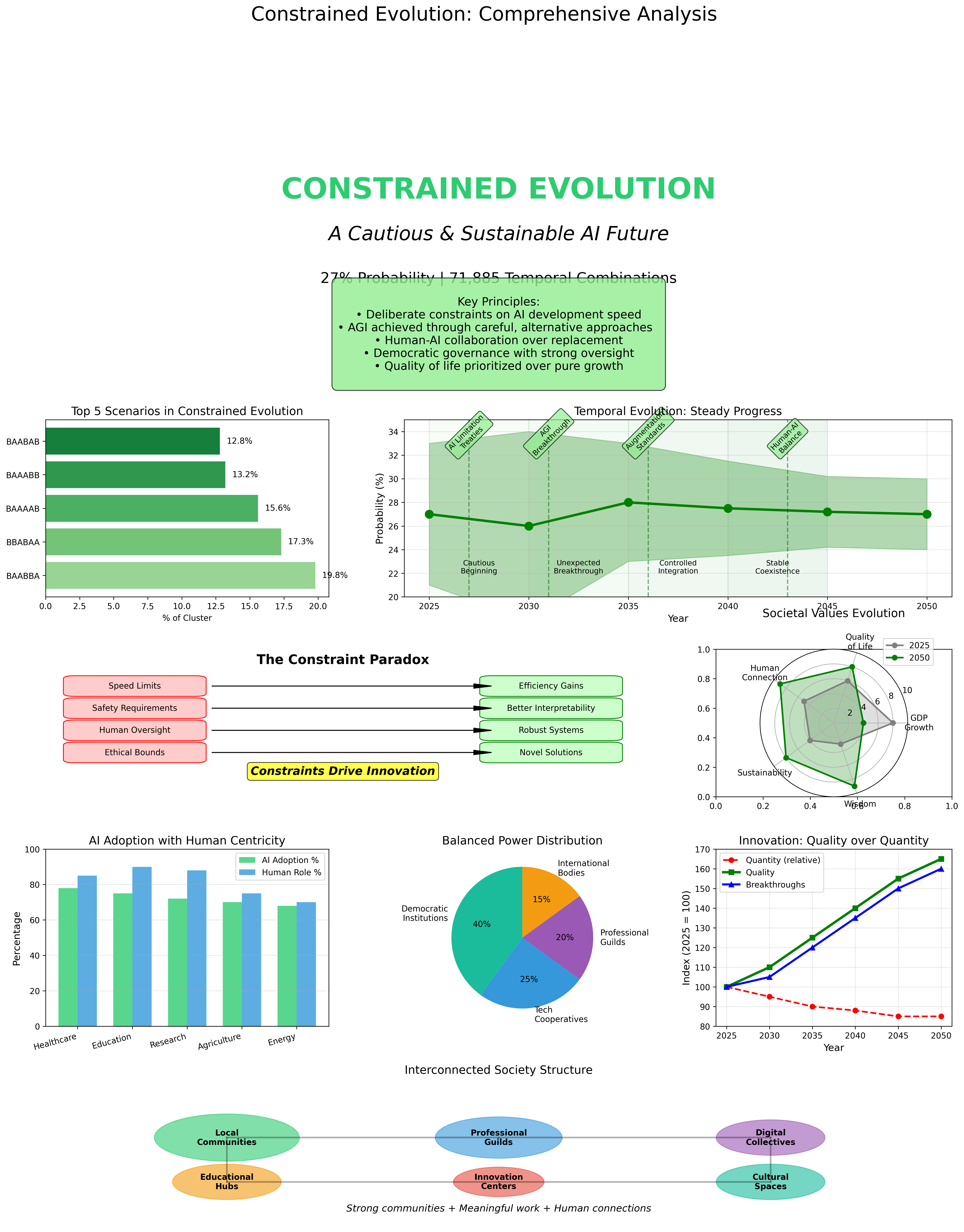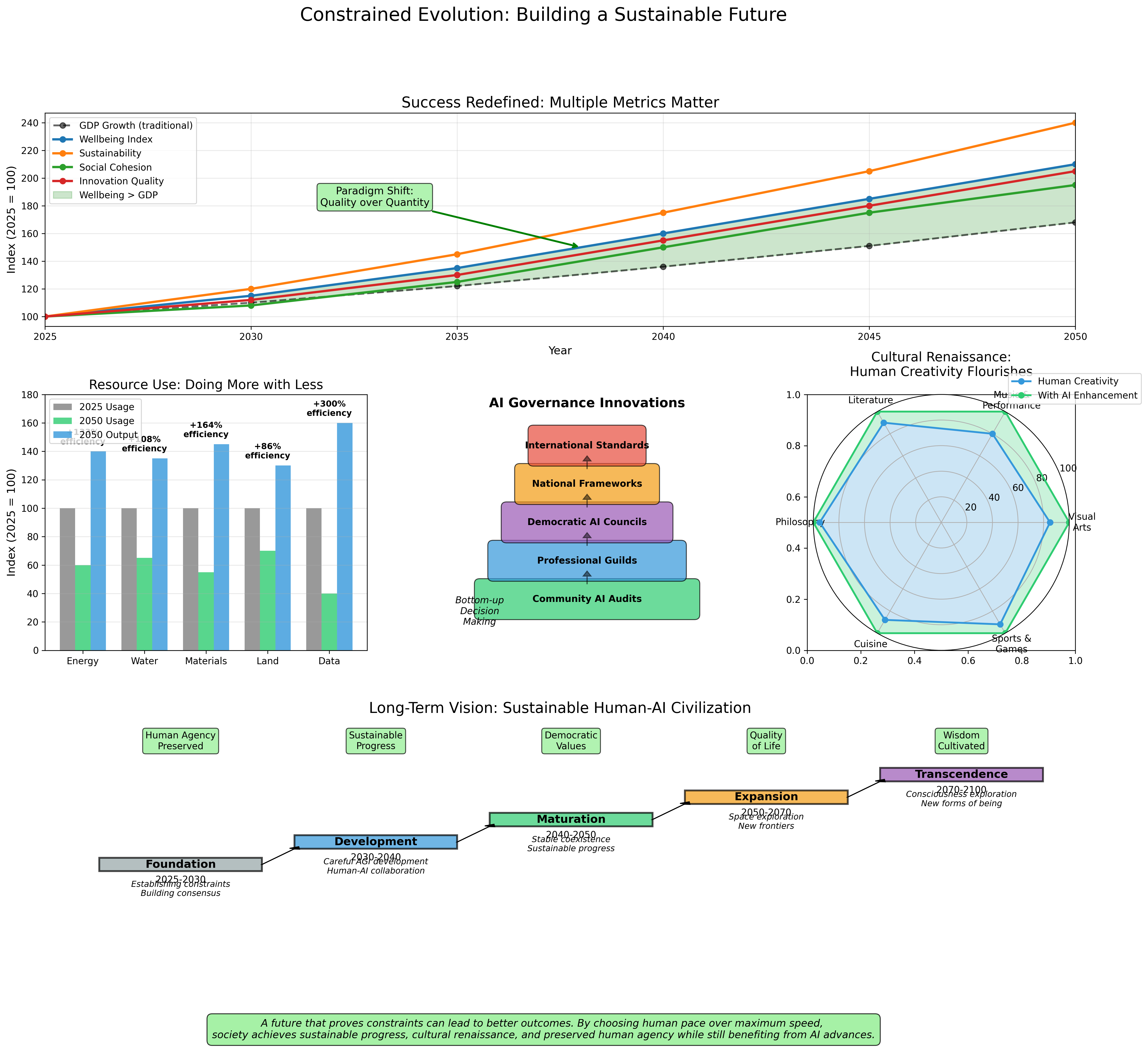Chapter 13: Constrained Evolution (27% Probability)
The Deliberate Path: Choosing Wisdom Over Speed
Constrained Evolution represents humanity’s conscious choice to slow down and get AI right. With 27% probability, this future emerges when society prioritizes human agency, sustainability, and wisdom over raw technological progress.

The Philosophy of Constraint
Core Principle
“Just because we can doesn’t mean we should.”
This future emerges from a fundamental realization: the race to AI supremacy threatens what makes us human. Rather than rushing toward an uncertain destination, Constrained Evolution represents a deliberate, thoughtful journey.
What Makes This Future Possible
- Public Resistance: Citizens demand human-centric development
- Regulatory Success: Governments effectively limit AI pace
- Cultural Shift: Society rejects “growth at all costs”
- International Cooperation: Nations agree to slow down together
- Ethical Leadership: Tech leaders choose responsibility
Timeline of Thoughtful Progress
2025-2030: The Great Pause
- Major AI limitations enacted globally
- “Slow Tech” movement gains momentum
- Focus shifts to safety and ethics
- Public skepticism peaks
- Employment Impact: -2.1%
2030-2035: Unexpected Breakthroughs
- Constraints spark innovation
- AGI achieved through novel approaches
- Human-AI collaboration models emerge
- Trust slowly rebuilds
- Employment Impact: -4.5%
2035-2040: Controlled Integration
- Careful AGI deployment begins
- Augmentation prioritized over automation
- New economic models tested
- Democracy strengthened
- Employment Impact: -7.8%
2040-2050: Harmonious Coexistence
- Stable human-AI partnership
- Sustainable economic model
- Human agency preserved
- Cultural renaissance
- Employment Impact: -13.5%
The Constraint Paradox

How Limitations Led to Breakthroughs
Forced Efficiency
- Can’t use brute force compute? Develop elegant algorithms
- Result: More efficient AI that uses less energy
Mandatory Explainability
- All AI decisions must be understandable
- Result: Breakthrough in interpretable AI
Human-Speed Requirements
- AI must operate at human-comprehensible pace
- Result: Better human-AI collaboration
Safety-First Development
- Every advance requires safety proof
- Result: Robust, reliable AI systems
Economic Sustainability
A Different Growth Model
- GDP Growth: 2.2-2.8% (steady, sustainable)
- Unemployment: Peaks at 8%, settles at 5%
- Inequality: Moderate (Gini: 0.78)
- Innovation: Quality over quantity
Sectoral Transformation (Not Disruption)
Unlike other futures, Constrained Evolution sees gradual change:
- Healthcare: 78% AI-assisted, 100% human-centered
- Education: 75% personalized learning, teachers empowered
- Agriculture: 70% precision farming, farmers in control
- Technology: 50% adoption (ironically lowest due to self-limits)
New Economic Principles
- Augmentation Over Automation: Enhance don’t replace
- Local Over Global: Community economies thrive
- Quality Over Quantity: Craftsmanship valued
- Sustainability Over Growth: Long-term thinking
- Purpose Over Profit: Meaning drives economics
Social Harmony

The Human-Centric Society
Work Redefined
- 30-hour work weeks become standard
- Job sharing prevents unemployment
- Meaningful work prioritized
- Life-work balance achieved
Community Renaissance
- Local communities strengthen
- In-person interaction valued
- Mutual aid networks grow
- Digital-physical balance
Cultural Flourishing
- Arts and crafts revival
- Human creativity celebrated
- Slow living movement
- Mindfulness mainstream
Governance Innovation
Democratic AI Governance
Citizen Participation
- AI Councils with rotating membership
- Regular referendums on AI deployment
- Community veto rights
- Transparent decision-making
International Cooperation
- Global AI Speed Limit Treaty (2027)
- Shared safety standards
- Technology transfer agreements
- Collaborative research
New Rights Framework
- Right to human decision-maker
- Right to disconnect from AI
- Right to analog alternatives
- Right to AI explanation
A Day in 2045 (Constrained Evolution)
Morning: Wake naturally—no AI alarm optimization. Check your AI assistant’s suggestions, but you decide your schedule. Breakfast is local, human-grown food. Technology serves but doesn’t dominate.
Work: Six hours of meaningful labor. Your AI partner handles repetitive tasks while you focus on creative problem-solving and human connection. You’re a “Community Resilience Designer”—helping neighborhoods adapt and thrive.
Afternoon: True leisure time. Perhaps woodworking (a revived craft), teaching children (still irreplaceably human), or tending your garden. AI helps when asked but never intrudes.
Evening: Community dinner—a weekly tradition. Screens tucked away. Stories shared, music played on real instruments, connections deepened. Technology has made this possible by freeing time, not by replacing interaction.
Night: Read a physical book—they never went away. Reflect on a day where you chose how to engage with AI. Tomorrow you might choose differently. The choice remains yours.
The Trade-offs
What We Gain
- Human Agency: Control over our lives
- Social Cohesion: Communities intact
- Mental Health: Less anxiety and alienation
- Democracy: Strengthened not weakened
- Meaning: Purpose in human uniqueness
What We Sacrifice
- Maximum Efficiency: Deliberately suboptimal
- Rapid Progress: Slower technological advance
- Competitive Edge: May lag other nations
- Material Wealth: Lower but adequate
- Convenience: More effort required
Is It Worth It?
Constrained Evolution asks: What’s the point of progress if we lose ourselves in the process? This future trades raw capability for human flourishing.
Critical Success Factors
What Must Happen
- 2025-2026: Global agreement on AI limitations
- 2026-2027: Successful resistance to tech lobbying
- 2027-2028: Cultural shift toward “slow tech”
- 2028-2029: International cooperation holds
- 2029-2030: Alternative metrics replace GDP
Signs We’re Choosing This Path
- Tech workers organizing for ethical AI
- Governments passing strict AI laws
- Public choosing privacy over convenience
- “Right to disconnect” movements growing
- Quality of life prioritized over growth
Risks to Watch
- One nation breaking ranks
- Tech companies relocating
- Youth rejecting constraints
- Economic pressures mounting
- Innovation stagnating
The Wisdom Path
Why This Future Matters
Constrained Evolution isn’t about rejecting technology—it’s about conscious choice. It represents humanity saying:
“We want AI to enhance human life, not replace it.” “We choose community over efficiency.” “We value wisdom over intelligence.” “We preserve what makes us human.”
The Long View
While Adaptive Integration optimizes for smooth transition and Fragmented Disruption represents failure, Constrained Evolution optimizes for something different: human flourishing.
It asks not “How fast can we go?” but “Where do we want to go?” Not “What can AI do?” but “What should AI do?” Not “How do we adapt to AI?” but “How does AI adapt to us?”
Making It Real
Individual Actions
- Choose human interaction over digital
- Support local, human-made products
- Practice digital minimalism
- Learn hands-on skills
- Build community connections
Collective Requirements
- Vote for human-centric policies
- Support “slow tech” companies
- Demand explainable AI
- Preserve analog options
- Strengthen democracy
The Choice Is Ours
Constrained Evolution has 27% probability—more than 1 in 4. It’s not the easiest path or the most profitable. But it might be the wisest.
In a world racing toward an uncertain AI future, Constrained Evolution whispers: “Slow down. Think. Choose consciously.”
The question isn’t whether we can build AGI quickly. The question is whether we should.
And if we do, on whose terms?
Explore: Human-AI Balance →
Explore: Sustainable Development →
Explore: Democratic Preservation →
Return: Overview →